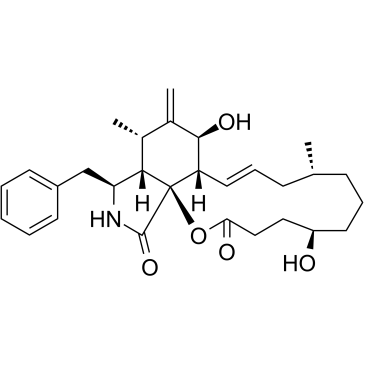Dihydrocytochalasin B

Dihydrocytochalasin B structure
|
Common Name | Dihydrocytochalasin B | ||
|---|---|---|---|---|
| CAS Number | 39156-67-7 | Molecular Weight | 481.62400 | |
| Density | 1.194g/cm3 | Boiling Point | 727.474ºC at 760 mmHg | |
| Molecular Formula | C29H39NO5 | Melting Point | 203-205ºC | |
| MSDS | Chinese USA | Flash Point | 393.762ºC | |
| Symbol |


GHS06, GHS08 |
Signal Word | Danger | |
|
Tetraploidization increases sensitivity to Aurora B kinase inhibition.
Cell Cycle 11(13) , 2567-77, (2012) Aurora kinases are overexpressed in many cancers and are targets for anticancer drugs. The yeast homolog of Aurora B kinase, IPL1, was found to be a ploidy-specific lethality gene. Given that polyploidization is a common feature of many cancers, we hypothesiz... |
|
|
Centrifugal and chromatographic analyses of tryptophan and tyrosine uptake by red blood cells and GLUT1 proteoliposomes with permeability estimates and observations on dihydrocytochalasin B.
J. Biochem. Biophys. Methods 55(2) , 127-40, (2003) We analyzed transport into liposomes and proteoliposomes, separated the free and internalized radioactively labeled substrates by size-exclusion chromatography (SEC) and observed a net influx owing to nonfacilitated diffusion across the lipid bilayers during ... |
|
|
Degradation and recycling of the substrate-binding subunit of type II iodothyronine 5'-deiodinase in astrocytes.
J. Biol. Chem. 271(27) , 16369-74, (1996) Thyroxine dynamically regulates levels of type II iodothyronine 5'-deiodinase (5'D-II) by modulating enzyme inactivation and targeting the enzyme to different pathways of internalization. 5'D-II is an approximately 200-kDa multimeric protein containing a 29-k... |
|
|
Complex regulation of human neutrophil activation by actin filaments: dihydrocytochalasin B and botulinum C2 toxin uncover the existence of multiple cation entry pathways.
J. Leukoc. Biol. 61(6) , 703-11, (1997) In human neutrophils, the chemotactic peptide, N-formyl-L-methionyl-L-leucyl-L-phenalalanine (fMLP), the Ca(2+)-ATPase inhibitor, thapsigargin, and the lectins, concanavalin A (Con A) and mistletoe lectin I (ML I), stimulate the entry of Ca2+ and Na+ with sub... |
|
|
Disruption of the actin cytoskeleton leads to inhibition of mitogen-induced cyclin E expression, Cdk2 phosphorylation, and nuclear accumulation of the retinoblastoma protein-related p107 protein.
Exp. Cell Res. 259(1) , 35-53, (2000) The actin cytoskeleton has been found to be required for mitogen-stimulated cells to passage through the cell cycle checkpoint. Here we show that selective disruption of the actin cytoskeleton by dihydrocytochalasin B (H(2)CB) blocked the mitogenic effect in ... |
|
|
2-Hydroxymethyl-1-naphthol diacetate (TAC) suppresses the superoxide anion generation in rat neutrophils.
Free Radic. Biol. Med. 26(7-8) , 1010-8, (1999) We have investigated the inhibitory effect of 2-hydroxymethyl-1-naphthol diacetate (TAC) on the respiratory burst of rat neutrophils and the underlying mechanism of action was also assessed in this study. TAC caused concentration-related inhibition of the for... |
|
|
Farnesylpyridinium, an analog of isoprenoid farnesol, induces apoptosis but suppresses apoptotic body formation in human promyelocytic leukemia cells.
FEBS Lett. 514(2-3) , 250-4, (2002) 1-Farnesylpyridinium (FPy), an analog of isoprenoid farnesol, initially induced morphological changes similar to those of typical apoptosis in human leukemia HL-60 cells but FPy-treated cells were characterized by the absolute absence of final apoptotic event... |
|
|
Modulation of the junctional integrity by low or high concentrations of cytochalasin B and dihydrocytochalasin B is associated with distinct changes in F-actin and ZO-1.
Biosci. Rep. 16(4) , 313-26, (1996) In a study of Necturus gallbladder epithelium Benzel et al. (Benzel et al., 1980) found that low (0.2-1.2 microM) and higher concentrations (1.5 microM and more) of cytochalasin B (CB) caused an increase and decrease in the transepithelial electrical resistan... |
|
|
Latrunculin and cytochalasin decrease chondrocyte matrix retention.
J. Histochem. Cytochem. 50(10) , 1313-24, (2002) The proteoglycan-rich extracellular matrix (ECM) directly associated with the cells of articular cartilage is anchored to the chondrocyte plasma membrane via interaction with the hyaluronan receptor CD44. The cytoplasmic tail of CD44 interacts with the cortic... |
|
|
The N-formylpeptide receptor (FPR) and a second G(i)-coupled receptor mediate fMet-Leu-Phe-stimulated activation of NADPH oxidase in murine neutrophils.
Cell. Immunol. 218(1-2) , 7-12, (2002) N-Formylypeptides such as fMet-Leu-Phe (fMLF) potently induce superoxide production through NADPH oxidase activation. The receptors that mediate this response have not been defined. Here, we provide definitive proof using a mouse model that formyl peptide rec... |